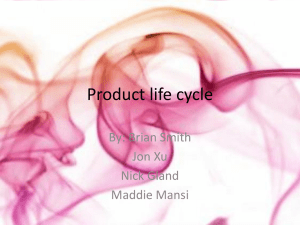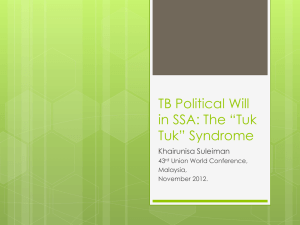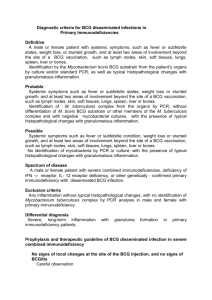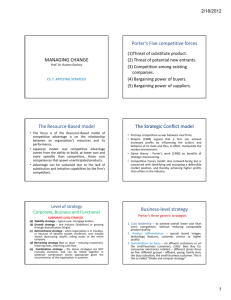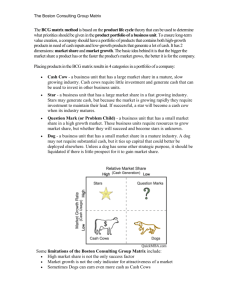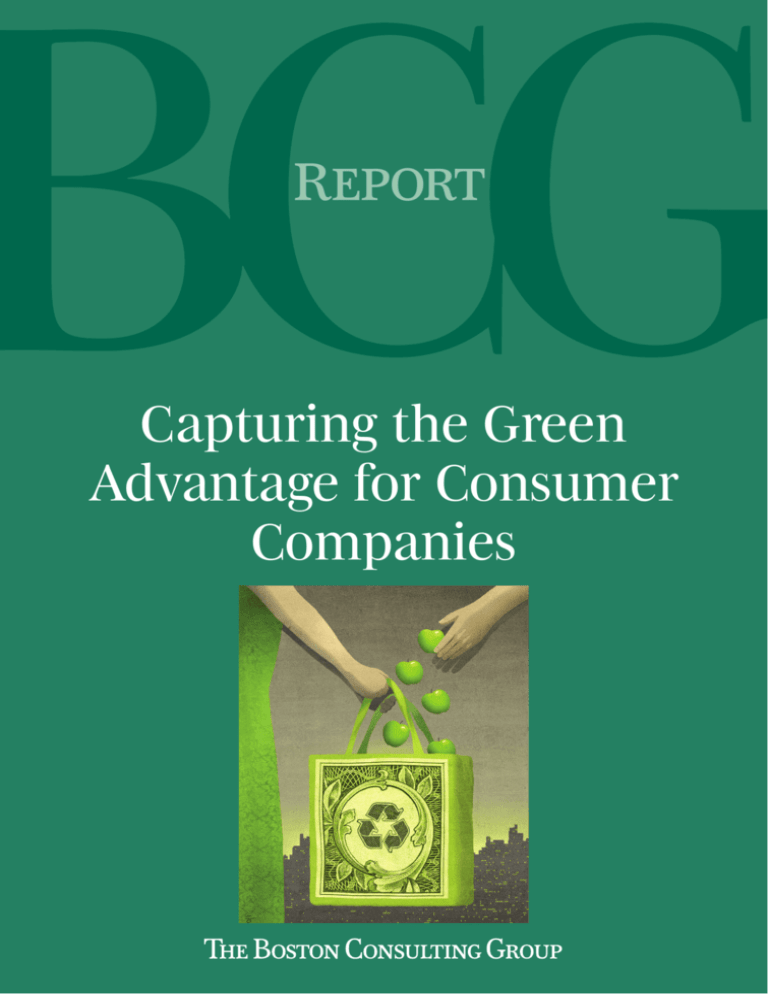
Report
Capturing the Green
Advantage for Consumer
Companies
The Boston Consulting Group (BCG) is a global management consulting firm and the world’s leading advisor on
business strategy. We partner with clients in all sectors
and regions to identify their highest-value opportunities,
address their most critical challenges, and transform their
businesses. Our customized approach combines deep in­
sight into the dynamics of companies and markets with
close collaboration at all levels of the client organization.
This ensures that our clients achieve sustainable compet­
itive advantage, build more capable organizations, and
secure lasting results. Founded in 1963, BCG is a private
company with 66 offices in 38 countries. For more information, please visit www.bcg.com.
Capturing the Green
Advantage for Consumer
Companies
Joe Manget
Catherine Roche
Felix Münnich
January 2009
bcg.com
© The Boston Consulting Group, Inc. 2009. All rights reserved.
For information or permission to reprint, please contact BCG at:
E-mail: bcg-info@bcg.com
Fax: +1 617 850 3901, attention BCG/Permissions
Mail: BCG/Permissions
The Boston Consulting Group, Inc.
One Beacon Street
Boston, MA 02108
USA
Contents
Note to the Reader
5
Introduction
6
Green Expectations
9
Green Shopping: Where It Matters Most
12
Who’s Afraid of a Green Premium?
14
Help Wanted: Consumers Lack Information and Navigation Assistance
18
Green Opportunities 20
Capturing the Green Advantage for Consumer Companies
3
4
The Boston Consulting Group
Note to the Reader
About the Authors
Joe Manget is a senior partner and
managing director in the Toronto office of The Boston Consulting Group.
Catherine Roche is a partner and
managing director in the firm’s Düsseldorf office. Felix Münnich is a
project leader in BCG’s Munich
office.
Acknowledgments
This report is a product of BCG’s
Consumer practice and its Center for
Consumer Insight (CCI), which provides world-class consumer-insight
capabilities to the firm’s clients. Established by the Consumer practice
and the Marketing and Sales practice,
the CCI leads BCG’s proprietary research for publications on consumer
trends and purchasing patterns. As
an advisor to companies in many industries, BCG has long recognized the
fundamental value of identifying and
leveraging insights into consumer behavior, both for strategy development
and as a key source of sustainable
competitive advantage.
The authors would like to acknowledge the contributions of their colleagues Patrick Ducasse, a senior
partner and managing director in
BCG’s Paris office and the global
leader of the Consumer practice;
Matt Anestis, a principal in the firm’s
Hong Kong office; Balu Balagopal,
a senior partner and managing director in BCG’s Houston office; Mary
Egan, a partner and managing director in the firm’s New York office;
Emmanuel Huet, a senior manager
in BCG’s Paris office and the leader
of the CCI; Holger Rubel, a partner
and managing director in the firm’s
Frankfurt office; Alison Sander, a globalization topic advisor; Jutta Trögel,
a consultant in BCG’s Munich office;
and Karin Zimmermann, the global
manager of the Consumer practice.
The authors also thank Pascal Engel,
Anja Schermer, and Sascha Seifert for
research and support.
Catherine Roche
BCG Düsseldorf
+49 2 11 30 11 30
roche.catherine@bcg.com
Asia-Pacific
Matt Anestis
BCG Hong Kong
+852 2506 2111
anestis.matt@bcg.com
Finally, the authors would like to
acknowledge Sally Seymour for helping to write this report and Gary
Callahan, Mary DeVience, Kim
Friedman, and Gina Goldstein for
contributions to its editing, design,
and production.
For Further Contact
For more information, please contact
one of the following leaders of the
Consumer practice:
The Americas
Joe Manget
BCG Toronto
+1 416 955 4200
manget.joe@bcg.com
Europe
Patrick Ducasse
BCG Paris
+33 1 40 17 10 10
ducasse.patrick@bcg.com
Capturing the Green Advantage for Consumer Companies
5
Introduction
T
hanks to unpredictable prices at the pump,
energy-saving technologies, and the success
of Al Gore and other experts in making us
face “inconvenient” truths, consumers
around the world are starting to talk about
the environment as if they were discussing their own
backyards (which, of course, they are). Concerns about
the sustainability of resources and the safety of what we
put into and on our bodies have become a staple of the
mainstream media. As a result, green—the global catchall term for everything good for the environment—has
become a significant factor in where consumers shop and
what they buy.
But will consumers continue to care about green issues
now that the economy has taken a nosedive? That’s the
question companies the world over are asking as they
consider their past investments in green strategies and
plan for the years ahead. The answer, our research convinces us, is a resounding yes. Consumers and companies
have come to accept volatile energy prices as a fact of life,
and they won’t be quick to forget the sting of soaring
prices in the first half of 2008. Worries about the cost and
depletion of natural resources are front and center in everyone’s mind—and budget.
Our research also indicates that consumers greatly value
the direct benefits that green products offer, such as superior freshness and taste, the promise of safety and
health, and savings on energy costs. In an October 2008
survey on trading-up behavior, The Boston Consulting
Group found that more consumers systematically purchased green products in 2008 than in 2007. (See Exhibit
1.) Moreover, more consumers were willing to pay a higher price for green products deemed to be of higher quality. For example, although consumers everywhere are
6
cutting back on big-ticket items in the face of a deep recession, they are reluctant to cut back on organic foods.
In fact, when survey participants were asked in which
product categories they were willing to trade up, they
ranked organic foods 20 on a list of 108 product categories—considerably higher than the ranking of 43 they assigned to the category in a similar survey conducted in
2006. Organic has come to stand for better quality—an
affordable luxury that is also good for you.
Of course, the actions a company takes on behalf of the
environment must also be good for its bottom line—
whether by bringing down costs or by offering product
features that attract more consumers. Therefore the continuing expansion of green consciousness around the
world presents a huge opportunity for smart companies,
and the business case for green remains compelling
even—and, in many cases, especially—in a tough
market.
At its core, the green movement is about reducing waste
and minimizing our impact on the environment. Companies that translate these goals into a holistic approach to
offering differentiated green products and bringing down
costs across the entire value chain have been rewarded
with higher margins and market share.
Nevertheless, producers and sellers of green products still
face some challenges. There is considerable confusion
around the world about what being green really means.
Because the industry lacks clear definitions and standards, some companies have been able to make sweeping
and unsubstantiated claims about their environmental
credentials. That has caused many consumers to become
skeptical about green products, and companies to become wary of offering them. Companies are looking for
The Boston Consulting Group
Exhibit 1. Despite the Economic Downturn, Consumers Still Care About Green Products
Because the forces driving the
green movement haven’t changed...
1 1 Energy prices are still volatile
2
Concerns about product
and food safety are still high
3 3 Governments remain interested
in environmental issues
4
...consumer demand for
green products is still rising
32
34
20
I systematically
look for and
oen purchase
green products
24
A higher price for
green products is
acceptable to me
There’s a more compelling business
case than ever for reducing costs
5 5 The environment is not getting
any cleaner on its own
Percentage of
respondents, 2007
Percentage of
respondents, 2008
Source: BCG/Lightspeed Research survey, October 2007 and October 2008.
Note: Data are from a survey of more than 2,000 European adults with an annual income equivalent to $35,000 or more.
business-minded approaches to protecting the environment that consumers will trust. But since consumers’ expectations for green products and production processes
differ depending on where they live and the products
they buy, companies must discover how targeted segments feel about the environment, what they expect from
green products, and what prices they are willing to pay.
In July 2008, BCG conducted its Global Green Consumer
Survey to assess green attitudes and shopping behaviors.
We surveyed approximately 9,000 adults, aged 18 to 65,
in nine countries through online questionnaires sent to
respondents in Canada, France, Germany, Italy, Japan,
Spain, the United Kingdom, and the United States and—
in order to get a sense of the opinions of consumers in
emerging markets—through face-to-face interviews in
seven major cities in China. Our questions explored consumers’ awareness of environmental issues, their behavior when shopping for green products, their willingness
to pay a premium for green products in more than 50
categories, and their perceptions of green retailers and
brands. Finally, we interviewed executives at 20 leading
consumer companies about their green strategies and
experiences.
more effective than private individuals in acting on green
issues, including health and safety, and they expect companies to do so. But consumers are uncertain about exactly what that entails, and they want advice they can
trust in evaluating product claims. Second, and contrary
to what many managers believe, consumers are willing to
pay a little more for some green products—even in times
of tighter budgets—if they believe such products are
healthier, safer, or better for the environment. Finally,
most of the consumers we spoke with consider a store’s
green credentials when choosing where to shop—a clear
opportunity for savvy retailers.
Still, to attract more green shoppers, both retailers and
manufacturers need to improve consumers’ awareness
of green products and the choices available. Despite
all the media attention the green movement has received, consumers remain unaware of green options in
many categories and believe that the choices are limited
when compared with conventional alternatives. Many
consumers, for instance, complain about the “green ghetto” in the supermarket, where a limited assortment of
organic products are crowded together in a low-traffic
location.
The results of our research clearly indicate that when it
comes to being green, consumers hold companies to a
high standard. First, they believe that companies can be
Winning the hearts (and wallets) of green consumers is a
wise move for producers and retailers. But going green is
not merely a tactic for a single product or a discrete proc-
Capturing the Green Advantage for Consumer Companies
7
ess. Rather, companies should strategically employ what
we call the four Ps of green advantage: green planning,
which incorporates green targets and resources into corporate strategy; green processes, which allow companies
to practice what they preach; green product offerings; and
green promotion and messages. (See Exhibit 2.) This re-
port provides a window onto how consumers’ perspectives on green products and services are evolving and
offers recommendations on how companies can meet
their customers’ demands for a greener environment
while also meeting their own business requirements.
Exhibit 2. The Four Ps of Green Advantage Employ a Holistic Approach
Across the Value Chain
Planning
Processes
◊ Embedding green targets and
resources into corporate strategy
◊ Reducing waste in operations
G
PR
O
IN
CE
AN
N
SS
PL
◊ Talking about green issues with
key stakeholders
◊ Encouraging others (suppliers,
customers, and employees)
to operate in a green way
S
Products
PR
O
O
TI
CT
M
U
◊ Communicating the company’s
message on sustainability and
green issues
ES
O
D
Promotion
N
PR
O
◊ Planning for and capitalizing on
changes on the horizon
◊ Determining offerings, packaging,
and pricing
◊ Innovating to help consumers
live greener
◊ Knowing which green benefits
really matter to consumers
Source: BCG analysis.
8
The Boston Consulting Group
Green Expectations
C
onsumers around the world are very worried about the environment. In fact, about
two-thirds of our survey participants—especially those in France and Italy—said they
believed that the environment is in bad
shape. More than 80 percent of the Japanese consumers
we surveyed claimed that environmental problems are a
primary threat to society, while U.K. and U.S. consumers
ranked concerns about the environment just below concerns about the current economic downturn. On average,
only about 12 percent of consumers said they were skeptical about threats to the environment.
When asked who should address environmental issues,
consumers said that they should shoulder some of the responsibility. Nearly half (46 percent) of survey participants
strongly agreed that the actions of individuals can help
protect the environment. But many seem to hold companies to a higher standard. Fully 73 percent of consumers
consider it important or very important that companies
have a good environmental track record. (See Exhibit 3.)
We found that the term green is recognized the world over
as shorthand for environmental consciousness. Yet when
we asked consumers precisely how they define green,
their answers varied depending on where they live and
the type of product. (See Exhibit 4.) Of course, survey
participants everywhere believe that being green entails
activities that have a direct and positive impact on the
environment, but many also include activities that could
be considered a part of social responsibility, such as compliance with fair-trade requirements. Among Italians, for
example, excluding animal testing is considered an important component of being green, whereas that factor
matters much less to Japanese consumers. Some consumers even believe that handmade or locally grown prodCapturing the Green Advantage for Consumer Companies
ucts qualify as green. The importance of recyclable materials also varies greatly across markets; for example, they
are highly relevant in the United States but carry much
less weight in Germany.
Although some countries are trying to define green products and businesses more precisely, no clear global standard has emerged yet. Therefore it is critical that companies understand what green means to the consumers in
their targeted markets and in specific product categories.
Meeting this goal may be harder than it appears, since
consumers are notoriously poor at understanding or communicating the complex motives that drive their behavior. For instance, consumers in our survey who make a
point of purchasing green products claimed that they do
so primarily for altruistic or health-related reasons—because they care about the environment and want their
families to live in a better, healthier, and safer world. Only
a few consumers claimed that they purchase green products for other reasons, such as to save money. This finding
held true across all the countries surveyed.
Interestingly, when we asked consumers what they are
doing for the environment, the most popular of the actions cited save money as well. (See Exhibit 5.) These include turning off home electronics when not in use, recycling or reusing products, using less water, and using
energy-efficient appliances and light bulbs. Even more
consumers plan to take these steps in the future. In contrast, consumers are not nearly as likely to take less convenient or more costly actions, such as buying a hybrid
car. Not surprisingly, many companies have found that
the most successful programs to protect the environment
are those that also help consumers save money. (See the
sidebar “Tesco’s Fashionable Bags.”)
9
Exhibit 3. Most Consumers Think It Is Important or Very Important
for Companies to Be Green
Companies should be clear about product risks and safety
81
Companies should provide information on environmental impact
75
Companies should have high ethical standards
75
Companies should have a good environmental track record
73
Companies should treat employees fairly
71
Companies should offer green products
66
Companies should be involved in social projects
54
Companies should donate to charity
43
Percentage of respondents
Important
Sources: BCG Global Green Consumer Survey, 2008; BCG analysis.
Note: Data are from 1,000 responses across all countries in our survey.
Very important
Exhibit 4. Consumers Around the World Define Green Differently
What are green products?
Products that can be recycled or reused
76
Products that generate less pollution in their production or use
87
90
70
Products that are made of recycled materials
84
68
68
Products that are produced in an eco-friendly way
Products that consume less energy in their production or use
91
81
80
63
Products that involve less packaging
67
Products that have a smaller carbon footprint
86
82
60
57
Products that are made of natural or organic materials
Products that are made of fewer materials
81
44
Products that are certified as green
58
Products that use innovative technology
78
45
Products that are not tested on animals
73
23
63
Products that are made under fair-trade conditions
42
Products that are produced locally
69
54
35
Products that are handmade
47
22
0
10
20
30
40
50
60
70
80
90
100
Percentage of respondents who
agreed or strongly agreed
Country with the lowest
percentage of respondents
who agreed
XX
Country with the highest
percentage of respondents
who agreed
Percentage of all respondents
XX
Sources: BCG Global Green Consumer Survey, 2008; BCG analysis.
Note: Data are from 1,000 responses across all countries in our survey.
10
The Boston Consulting Group
Exhibit 5. The Most Popular Green Behaviors Are Also Budget Friendly
What actions will you take to be green, today and in the future?
Today
In the future
Turn off home electronics when not in use
Recycle or reuse products
Use low-energy light bulbs
Use less water
Bring my own bags to the grocery store
Use energy-efficient appliances
Use my car as little as possible
Purchase locally produced products
Improve insulation in my home
Buy products without packaging
Buy fewer products
Spend my vacations at or near home
Travel less for work
Travel by train whenever possible
Buy organic food
Drive a more fuel-efficient car
Eat less meat
Shop more oen at green stores
Don’t own a car
Invest in environmentally friendly funds
Own a hybrid car
100
75
50
25
0
Percentage of respondents
0
25
50
75
100
Sources: BCG Global Green Consumer Survey, 2008; BCG analysis.
Note: Data are from 8,047 responses across all countries in our survey, excluding China.
Tesco’s Fashionable Bags
Customers at Tesco grocery stores in the United Kingdom
were happy to purchase reusable shopping bags when the
company began offering at least one Green Clubcard
point for each bag used, depending on its size. (Green
Clubcard points have the same value as regular Clubcard
points but are awarded for actions that benefit the environment.) And customers don’t have to use Tesco’s bags
to rack up points: they get credit for using bags from other
retailers, too.
Since the program was launched, in August 2006, customers have used 2 billion fewer disposable bags. Preferring
carrots to sticks, Tesco doesn’t charge its customers for
disposable bags when they forget their own reusable
ones (as many other retailers do), because, as one Tesco
official explained, “even the most committed greenies occasionally forget to bring their shopping bags with them.”
But to reduce those lapses, Tesco sent its Clubcard customers a key fob that carries a reminder to bring their
own bags.
Capturing the Green Advantage for Consumer Companies
Last year, Tesco introduced a line of attractive and affordable reusable shopping bags made from recycled plastic
bottles and designed by Cath Kidston—one of Britain’s
best-loved designers. The company originally commissioned six designs, but the bags were so popular that it
added two more, including one for Christmas. Each bag
costs £3.50, of which Tesco donated 50 pence in 2008 to
Marie Curie Cancer Care, its charity of the year.
Reusable bags are available at all Tesco stores in the United Kingdom, and the chain is expanding the program to
its stores throughout Europe. In Poland, for instance,
where customers use 400 million disposable bags each
year, it has extended its line of reusable bags to include a
jute bag that sells at a rate of 30,000 per month. Tesco
also offers smaller carrier bags at stores where customers
tend to buy less, such as Tesco Express convenience
stores.
11
Green Shopping
Where It Matters Most
F
or most consumers, green goes beyond shopping behavior. It encompasses nearly everything they do—and how that affects the
amount of energy they consume and the
amount of pollution they generate. Yet shopping green is increasingly an important way for consumers to act on their commitment to the environment. At
least half of our survey participants told us that they buy
green products regularly or sometimes. Europeans lead
in this behavior, with 54 percent of these respondents
reporting that they shop green regularly.
But if shopping green is common, shopping habits vary
considerably by product category. (See Exhibit 6.) A
slightly larger number of participants in our survey said
that they purchase green food products more often than
green nonfood products. Most popular in the food category are fresh meats and vegetables, which respondents
said taste better than conventional alternatives and can
be depended on for higher quality. Indeed, these foods
rank among the top three most frequently purchased
green products across all countries in our survey. Overall,
the percentage of consumers purchasing green products
is highest for paper and packaged products (such as paper towels, cleaning products, and trash bags)—a category in which green features are well entrenched, cheap,
and convenient. In all nine countries surveyed, 15 to 20
percent more consumers purchase green household
cleaners than purchase green products on average—and
an even higher percentage of consumers in France and
Canada reported buying green cleaners.
late is 4 percent more popular than green products on
average. Bottled water ranks among the top five green
products in China, Japan, and the United States, but Germans purchase it with below-average frequency. Green
appliances, such as energy-efficient cooktops and washing
machines, are much less favored in China, where most
consumers still wash their clothes by hand and government regulation keeps energy costs relatively low. (See the
sidebar “China’s Growing Environmental Awareness.”)
There’s no doubt that consumers all over the world are
increasingly choosing in favor of green products, but they
are also expecting more from the companies that make
and sell those products. The challenge for green-minded
companies is to understand which actions will be most
meaningful in their categories and for their customers.
Are consumers attracted to green products because they
leave a smaller carbon footprint? Because they are healthier and safer? Or because they cost less? In some cases, it’s
a combination of two or three features that makes for a
big hit. Tesco’s reusable shopping bags are successful, for
example, because customers are concerned about both
the environment and their pocketbooks—and because
the bags are well designed and attractive. Furthermore,
companies must be aware that the green qualities that
matter in one product, category, or country may not matter—or may not matter as much—in another.
There are differences across countries as well, as the popularity of organic chocolate illustrates. In Canada, organic
chocolate is 11 percent less popular with consumers than
are green products on average. But in Italy, organic choco12
The Boston Consulting Group
Exhibit 6. Consumers Vary Their Green Purchases by Product Category
21
24
28
36
37
40
40
41
41
46
48
46
50
51
63
10
10
9
10
12
11
12
11
12
12
12
14
14
13
12
Paper and packaged products
Disposable products for the home
Fresh meats and vegetables
Electronics and appliances
Health and beauty products
Frozen food
Home furnishings
Drinks
Packaged foods
Toys and games
Pet food
Restaurants and ready-to-eat meals
Textiles and clothing
Travel and transportation
Financial services
Respondents who have
never bought green (%)
Respondents who
sometimes buy green (%)
Respondents who
bought green
in the past but do
not currently buy
green (%)
Respondents who systematically
buy green (%)
42
42
42
27
24
22
29
36
40
31
35
36
32
28
33
28
27
19
25
14
10
18
13
12
10
13
7
8
10
7
Food products
Nonfood products
Sources: BCG Global Green Consumer Survey, 2008; BCG analysis.
Note: Percentages do not total 100 because of rounding. To calculate percentages for each product category, we averaged results across various
products.
China’s Growing Environmental Awareness
China’s rapid industrialization is having a huge impact on
the country’s environment in ways that consumers can
see every day. Air and noise pollution have grown more
troublesome, especially in urban areas. Pollution of freshwater reservoirs is threatening the water supply of millions of households and the livelihoods of people in rural
areas. But as significant as these problems are, they pale
before China’s milk scandal, in which thousands of children were sickened by industrial contaminants in September 2008.
The media spotlight on the 2008 Olympic Games brought
many of these problems to the attention of the world—
and to the attention of Chinese consumers. The government has promised remedies, but environmental regulators have no legal recourse and are seen by many
as toothless tigers. Nevertheless, many Chinese consumers are determined to do what they can to help the environment.
Capturing the Green Advantage for Consumer Companies
There is little incentive to purchase energy-efficient appliances in China because such products cost comparatively
more and, in any case, the price of electricity and water is
regulated by the government. So purchasing green in China generally means buying fresh foods. And because the
penetration of modern trade formats is still very low, the
Chinese purchase almost all their fresh food at so-called
wet markets, where prices are quite moderate. Wealthier
people, however—such as dual-income couples without
children—favor natural ingredients at any price and will
buy organic foods at hypermarkets, where they are much
more expensive.
13
Who’s Afraid of a
Green Premium?
M
any companies in the consumer industry believe that higher prices often
keep consumers from purchasing green
products. According to a manager at
one company that participated in our
survey, “It’s a no-brainer for most consumers—why
pay more? If prices were closer to what they are for conventional products, green sales would be much higher.”
But our findings show that price is not a significant
obstacle for most buyers. (See Exhibit 7.) In fact, it ranks
much lower as a barrier to green purchasing than lack of
awareness of green alternatives or a perceived lack
of choice. Furthermore, although some consumers, particularly those in China, are unwilling to pay a premium
for green products, fully one-third of consumers across
all the other countries we surveyed said they would pay
5 to 10 percent more for green products—if they were
convinced that the products offered direct benefits.
Of course, consumers’ willingness to pay more depends
on a product’s category and perceived benefits. To explore this further, we grouped products into five categories according to how consumers use them:
◊ Ingestible products, such as foods, beverages, and
over-the-counter drugs
◊ Products applied to the body, such as lotions, cleansers, and creams
◊ Wearable products, such as apparel and shoes
◊ Plug-in products, such as appliances and electronics
◊ Disposable products, such as paper and plastic products and household cleaners
14
We asked consumers to rate both the quality of green
products in these categories and their willingness to pay
a premium of 10 percent or more. The results were surprising. Nearly half of respondents in all countries said
that green products offer comparable or superior quality
over conventional alternatives. (See Exhibit 8.) In the ingestible-products category, about 30 percent of consumers are willing to pay a 10 percent premium or more for
fresh meats, seafood, produce, and dairy products—and
nearly two-thirds perceive green products in those categories to be superior. (See Exhibit 9.)
Willingness to pay a price premium is also fairly high in
the plug-in-products category, with between 20 and 30
percent of consumers open to paying a 10 percent premium or more over conventional offerings for some products. In this category, the money-saving benefit is a powerful motivator of green purchasing. Similarly, for
products applied to the body, the perceived benefit of
enhanced health fuels price premiums, since green is often a proxy for all-natural and healthier ingredients. In
the wearable-products category, 20 to 30 percent of consumers see green products as better than their conventional counterparts, and about the same proportion are
willing to pay a premium for them.
The results were somewhat different in the disposableproducts category. Here consumers are accustomed to
green alternatives and have almost come to expect green
attributes as a given. Therefore their willingness to pay a
premium for green products is lowest in this category.
Green features of disposable products clearly matter a lot
and can be a key lever for differentiating the quality and
appeal of product offerings—in terms of their safety or
ease of use, for example. But disposable products have a
limited ability to command a significant premium on
The Boston Consulting Group
Exhibit 7. Awareness and Choice—Not Price—Are the Most Powerful Levers
for Increasing Sales of Green Products
50%
of consumers buy green products today
50%
of consumers choose not to buy green products for various reasons...
Don’t think green products are
Relevance
12% relevant to their shopping needs
Awareness
34%
Are unaware
of green products
Don’t know where
to find green products
10%
Availability
Feel there are not enough
green-product options
16%
Prefer another
Don’t trust greenbrand
product claims
Choice
10%
Brand
Trust
4%
Quality
Think green products
2% are of lesser quality
Price
11% Think green products
are too expensive
Sources: BCG Global Green Consumer Survey, 2008; BCG analysis.
Note: About 4,000 respondents from all surveyed countries except China—about 50 percent of the respondents to our survey—were asked to indicate the
main reason why they had not recently bought green products. Percentages do not total 100 because of rounding.
Exhibit 8. Green Products Compare
Favorably with Conventional Products
How does the quality of green products
compare with that of conventional alternatives?
5
41
5
43
5
4
7
Respondents who
said the quality
is lower (%)
35
40
60
Respondents who
said the quality
is higher (%)
Sources: BCG Global Green Consumer Survey, 2008; BCG analysis.
Note: This question was asked of all respondents who indicated that
they had recently purchased green products. Data are from 1,000
responses across all countries in our survey; data from Europe are
from respondents in France, Germany, Italy, Spain, and the United
Kingdom.
Capturing the Green Advantage for Consumer Companies
green benefits alone; these attributes are viewed almost
as a commodity.
Being green is not a license to charge more. In all the
countries we surveyed except China, consumers will pay
more for green products, but only if they offer added
value. They must taste better, be safer or healthier, or
help consumers save money—on energy bills, for instance. (See Exhibit 10.)
But green products need not cost more. Many companies
could lower the price of green products by eliminating
as much as 16 percent of their own costs. Reducing
the amount of product packaging, for example, would
permit more products per truck and per shelf at the
store, thereby saving on fuel, logistics, and out-ofstock costs.
With better products and lower costs, everyone stands to
win—consumers, retailers, and manufacturers alike. This
is especially true in an economic downturn.
15
Exhibit 9. Consumers’ Willingness to Pay a Green Premium Depends on a Product’s
Category and Perceived Benefits
Percentage of green-product buyers willing to pay at least
10 percent more for green products in the category
35
Fresh
meats
Washing
machines
Children’s
apparel
30
Fresh
seafood
Baby
care products
Footwear
Dairy
products
Cooktops
Women’s and
men’s clothing
Consumer
electronics
25
Fresh fruits
and vegetables
Chocolate
Hair and
body care
Garden
Fragrances
20
Baby and
children’s food
Refrigerators
Small
kitchen
appliances
Fashion
accessories
Home
cleaning
Personal
hygiene
products
Dry and
canned food
Eggs
Baked goods
Skin care
Electricity/
energy
Snack Frozen providers
So food food
drinks
Condiments and sauces
Rubbish
bags
15
Coffee and tea
Bottled
water
Juices
Breakfast
cereals
Paper
10
20
25
30
35
40
45
Ingestible products
Plug-in products
Products applied to the body
Disposable products
50
55
60
65
70
75
Percentage of green-product buyers who said
that green products in the category are of
higher quality than conventional alternatives
Wearable products
Sources: BCG Global Green Consumer Survey, 2008; BCG analysis.
Note: Data are from 1,000 responses across all countries in our survey.
Price also affects merchandising. Consumers across all
countries told us that they want to see more green offerings at the stores where they shop. In many countries, as
many as two-thirds of survey participants said they would
shop more often at a store if it carried green products,
and an even larger proportion said they would buy more
green products if they were available.
To facilitate green shopping, retailers must manage the
tradeoff between convenience and price transparency. A
large majority of the consumers we spoke with would
prefer to see green products offered next to conventional
products on store shelves, rather than in a separate section. Of course, that arrangement makes price differences
more apparent, and retailers fear that consumers could
balk. But since many consumers are already prepared to
16
pay more for green features if the product offers added
value, and since fewer green products will be sold if they
are banished to a separate section, retailers may benefit
in the long run from displaying green and nongreen products together.
When we asked consumers to rate the “green competence” of the stores where they shop, the ones they rated
highest across several countries included Carrefour, Ikea,
Auchan, and Wal-Mart. The top stores in the United
States were Whole Foods Market and Trader Joe’s. In
Canada they were Loblaw and Ikea. And in the United
Kingdom they were The Body Shop and Marks and Spencer. It is interesting that our survey participants ranked
price second in terms of these companies’ competencies—further evidence that consumers aren’t as price
The Boston Consulting Group
Exhibit 10. Being Green Is Not a License to Charge More
Are you willing to pay a premium for green products if they provide added benefits?
19
27
31
18
29
30
24
29
18
30
Respondents
who said they
will pay a
premium up to
5 percent (%)
31
30
Respondents
who said they
will pay a
premium of
5 to 10
percent (%)
6
15
28
41
Respondents
who said they
won’t pay
more (%)
17
10
Respondents
who said they
will pay a
premium of
10 to 20
percent (%)
5
8
14
6
15
6
14
Respondents
who said they
will pay a
premium of
more than 20
percent (%)
Sources: BCG Global Green Consumer Survey, 2008; BCG analysis.
Note: This question was asked of all respondents who indicated that they had recently purchased green products. Data are from 1,000 responses across
all countries in our survey; data from Europe are from respondents in France, Germany, Italy, Spain, and the United Kingdom.
sensitive about green products as manufacturers and retailers might think. Instead they ranked choice and assortment first, suggesting that retailers should focus on
Capturing the Green Advantage for Consumer Companies
educating consumers about the benefits of green products and making it easier to locate green products in the
store.
17
Help Wanted
Consumers Lack Information and Navigation Assistance
N
early all the consumers in our survey reported being confused when shopping for
green products and uncertain about exactly what being green means, what benefits it provides, and how to tell if a product is green. Unfortunately, consumers gave manufacturers
and retailers a low ranking as sources of trusted information—well below organizations perceived to be independent and objective. When presented with a list of 13
sources of information about green products, most of the
survey participants in nearly all countries ranked independent consumer reports as the most credible source,
followed by academic and scientific publications, family
and friends, and nongovernmental organizations (NGOs)
and public-interest groups. Manufacturers were ranked
eighth, and retailers were even closer to the bottom of
the list.
Yet when we asked consumers how they judge whether a
product is truly green, one-half to three-quarters of respondents in each of the countries we surveyed admitted
that they rely on product advertisements, although an
even greater portion said they are skeptical about advertising claims. Consumers told us they often consult labels,
too, even though they don’t always believe them. Survey
participants in all countries said they usually assume that
a product is green if it carries clear labeling about its environmental impact. Yet only 28 percent said that they
understand the differences among various symbols for
green certification. And the vast majority of consumers,
especially in Europe, consider many certification labels
to be misleading. (See the sidebar “USDA Labels for Organic Foods.”)
In fact (as Exhibit 7 shows), lack of good information and
lack of awareness of green product offerings seem to be
18
the biggest reasons why consumers don’t purchase green
products. When we asked survey participants who said
they do not shop regularly for green products why they
don’t, 34 percent said they are unaware of green product
offerings in the categories in which they shop. Lack of
choice (“I’m not satisfied with the range of green product
offerings”) and relevance (“I don’t think green issues are
relevant in this product category”) were the next most
commonly cited reasons for not shopping green. Clearly,
retailers and manufacturers have some work to do in
making green options and benefits more visible to consumers. It is interesting that price (“I perceive green products as unreasonably priced”) ranks below these factors
as a barrier to green shopping.
As expected, the reasons for not purchasing green also
vary by category. In financial services, air travel, toys and
games, fragrances, and wine and spirits, consumers reported that lack of product awareness and a perceived
absence of choices are the main barriers. And even when
consumers are aware of green alternatives that they believe offer better quality, they still think there is insufficient choice in many categories. Some worry that if they
make a habit of purchasing green products, they will be
boxed into limited options. About 8 percent of survey
participants said they had stopped purchasing green because of a lack of choice.
We estimate that companies lose, on average, nearly 20
percent of potential purchasers when consumers aren’t
adequately informed about their green-product offerings.
Some companies are rising to this challenge by improving
their advertising of green products and striving to earn
consumers’ trust in their green credentials. One popular
strategy is to partner with respected NGOs and government agencies for the purpose of solving an environmenThe Boston Consulting Group
tal problem. Not only are such partnerships likely to
have a greater impact than efforts undertaken by companies on their own, but the company also benefits from
the associated publicity and goodwill while avoiding
claims of greenwashing. (See the sidebar “Partnering
with NGOs.”)
USDA Labels for Organic Foods
Partnering with NGOs
When organic products began to hit the shelves in the
1970s—and for several years thereafter—the efforts
of government agencies and NGOs in the United
States to certify them created chaos. Both private organizations and individual state governments began
to generate their own standards, resulting in overlapping standards as well as countless arguments among
labeling agencies about how to certify products containing multiple ingredients.
Unilever provides a good example of partnering for
green action. At one time, the company produced a
brand of packaged frozen fish, but because overfishing had led to a serious decline of its fishing stock in
the 1990s, it feared for the future of its fishing business. In response, Unilever worked with the World
Wildlife Fund (WWF) to create the Marine Stewardship Council (MSC), which established what has become the leading global standard for certifying sustainable wild-capture fisheries. To be certified to the
MSC standard, fisheries must prove that they do not
overfish their stocks, that their fishing practices do
not damage the marine ecosystem, and that they
have strong management systems in place to ensure
compliance.
These varying and conflicting claims forced industry
players that wanted access to foreign markets to take
on either the costs of private accreditation or the
equally steep costs of having their overseas shipments
certified one at a time. Finally, the U.S. Department of
Agriculture (USDA), with participation from several retailers (including Whole Foods Market), came to the
rescue with a single USDA label for all organic foods.
The USDA program set standards for organic farming
and handling, and its seal may be used only on agricultural products that are between 95 and 100 percent
organic (there are penalties for misuse). So far, 10,000
companies participate in the program and 25,000
products have been certified.
Capturing the Green Advantage for Consumer Companies
Initially a WWF project that was jointly funded by Unilever, the MSC became a completely independent
nonprofit in 1999. Today the organization certifies
7 percent of the world’s edible wild-caught fish. Many
other companies, including Metro, Whole Foods Market, Sainsbury’s, and Wal-Mart, have started sourcing
from MSC-certified fisheries.
19
Green Opportunities
O
ur research proves that green matters to
consumers around the world, and green
strategies offer companies and retailers a
competitive advantage in product differentiation and cost savings. Many companies understand this and are starting to take action. Indeed, green initiatives have emerged across nearly all
consumer sectors, including automobiles, electronics, durables, energy, health care, packaged goods, and retail.
Some players have succeeded in harnessing their “greenness” as a real competitive weapon—a path to leaner
operations, greater market share, and more attractive
brands. Others have encountered bumps in the road that
have resulted in higher costs, allegations of greenwashing,
and disaffected customers. What separates the winners
from the losers is a clear plan for how green the company
wants to be. Such a plan calls for a top-down vision and
coordination across the value chain—in other words, a
holistic approach to going green that enlists every part of
the organization: the four Ps of planning, processes, products, and promotion.
We’ve looked across the consumer industry and identified ten best practices for gaining a green advantage. Below we explore each practice, singling out a few companies as exemplars. Needless to say, most of the companies
we mention are working on several fronts, not just one
or two.
Planning
1. Factor sustainability into strategy, future resources, and
budgets. A leading hotel chain in Europe has been
tackling environmental issues since 1994 and highlights proactive sustainability as a core value in
its mission statement. In 2007, the company an20
nounced that it planned to halve its carbon-dioxide
emissions by 2011 and eliminate emissions entirely
by 2025.
2. Make the rules, don’t just follow them. Joining in industry
partnerships with respected certification programs is
a smart long-term investment. Many companies are
beginning to adopt the standards of a few of these
programs. One is the Energy Star label, created by the
U.S. Environmental Protection Agency in 1992 to
reduce energy consumption and greenhouse-gas
emissions from power plants. Some 2,000 manufacturers use the label, which appears on more than
40,000 energy-efficient products at more than 1,000
retailers.
3. Make a clear business case for sustainability initiatives. A
consumer-packaged-goods company was able to improve its balance sheet and help protect the environment through changes made to one of its householdcleaning products. By shrinking the product’s midsize
container by two-thirds and greatly increasing its concentration, the company was able to lower production
costs for water, cardboard, and resin; reduce logistics
costs through more efficient warehousing; decrease
the number of trucks needed to carry the product;
and increase sales through reduced out-of-stocks and
improved shelf efficiency. These moves increased
profits by about 16 percent.
Processes
4. Go green across the full value chain. Consumers have
wide-ranging expectations for green businesses, and
they—and their national governments—are likely to
grow even more demanding over time. These facts
The Boston Consulting Group
should spur companies to go beyond discrete, one-off
responses—a switch to recycled packaging, say, or the
offer of a low-fat alternative. Wal-Mart, which received
high ratings among our survey participants, is turning
itself into the reference company for green by its determination to put a green stamp on the entire life
cycle of the products it sells: the raw materials they
contain, how they are supplied and transported, how
they are displayed in the store, how they are used by
the customer, and how they are disposed of.
For example, Wal-Mart can provide farmers with an
incentive to produce organic cotton because it is the
world’s largest purchaser of this material. The company uses its sourcing clout with packaged-goods suppliers as well, in one instance working with a supplier
to make concentrated laundry detergent. That move
supported a program to increase the energy efficiency
of Wal-Mart’s truck fleet, since concentrated products
require smaller packages, which mean more product
onboard. In addition, the company is working toward
a goal it set in 2005 to reduce greenhouse-gas emissions by 20 percent in seven years at its stores, Sam’s
Club locations, and distribution centers. Efforts include such energy-saving steps as installing solar power, LED lighting, and white-membrane roofs. It also
tracks customers’ green-shopping habits across products and categories in order to keep on top of what
customers want. Finally, Wal-Mart has established a
zero-waste goal, which it is realizing by examining its
own waste stream and by increasing recycling. Currently the company recycles more than 30 different
commodities, including plastic film, prescription bottles, and paperback books, in its “super sandwich
bale” process. (See the sidebar “Wal-Mart Leads
the Way.”)
5. Target early wins to build momentum, credibility, and motivation. When developing a change agenda, it is essential to have the whole team onboard. An easy way
to rally the troops is to leverage quick wins. By replacing or retrofitting equipment such as lighting, toilets,
electronics, heating and air conditioning systems, and
water heaters, companies can demonstrate immediate results—with a return on investment as high as
150 percent in some cases. A national supermarket
chain with more than 400 stores saved $12.2 million
in one year by retrofitting lighting and installing energy management systems. An office building with
Capturing the Green Advantage for Consumer Companies
leasing revenues of $6 million a year recouped 25 percent of its investment by taking similar measures.
These are the kinds of results that inspire employees
and boards of directors to begin thinking and going
green.
6. Embed green goals into incentives and reporting structures. What gets measured gets done. In order to
achieve long-term, sustainable success, companies
need to transform their goals into specific initiatives
and integrate them into their overall reporting structure. Tesco has designed metrics that track such granular data as CO2 emissions by source. It has also introduced a set of key performance indicators that
measure these emissions against specific targets, such
as “reduce CO2-equivalent emissions from our existing
stores and distribution centers worldwide by at least
50 percent by 2020” and “restrict air transport to less
than 1 percent of our products.”
Wal-Mart Leads the Way
In 2004, when Wal-Mart became the largest private
user of electricity in the United States and one of the
largest owners of private truck fleets, the company decided to rethink its practices. It wound up initiating a
series of highly visible sustainability programs that
are driven from the top down. For example, the company recently announced that it will require its suppliers in China to adhere to environmental standards.
Over the next two years, Wal-Mart China will open a
prototype store that will use 40 percent less energy,
and it aims to reduce energy use by 30 percent and
water use by 50 percent at all of its stores.
Wal-Mart is counting on its tremendous buying power
to keep prices low, even as it demands more from suppliers in terms of quality and standards. It has signaled
that it is moving toward longer-term arrangements
with a smaller group of suppliers. To ensure that its
suppliers are making improvements, the company requires factory audits by both vendors and an outside
party, as well as random, unannounced audits by representatives of Wal-Mart itself.
Wal-Mart’s environmental program has resulted in an
immense improvement in public relations for the
company, and it has also become the foundation of a
very profitable sustainability strategy.
21
Products
7. Make sure consumers understand why your green product
is superior to all the others. As far back as 1997, Toyota
knew that automobile owners would become increasingly concerned about the effect of their driving on
the environment. Since then, advertising campaigns
for the Prius clearly spell out the hybrid’s environmental benefits as well as the excellence of its engineering. That has made the Prius the world’s most
well-known gas-and-electric hybrid vehicle. It is the
brand most consumers have in mind when they go
shopping for an automobile that will save money on
gas, reduce pollution, and announce to the world that
they care about the environment.
8. Get the pricing right. “Just because it’s a sustainable
product doesn’t mean it has to cost more,” says Matt
Kistler, senior vice president for sustainability at WalMart. “When buyers come to me expecting an environmentally friendly product to be more expensive
than the current one, I tell them they need to ask the
right questions. A green product should use less packaging and cost less for transportation. Sustainable
products should be the same price or less than the
products we are replacing.”
Companies should aim for products that are affordable as well as environmentally friendly. Yet it’s a mistake to jump to the conclusion that consumers won’t
pay more for green. If all possible costs have been
taken out and the green product is still priced higher,
consumers will pay the difference if they value the
additional benefits in health or safety. That’s why it’s
necessary to make sure that such benefits are communicated as fully as possible.
Promotion
ers can afford. By staking their own names and reputations on these promises, Wal-Mart’s leaders have
overcome a good deal of skepticism about how serious the world’s largest retailer is about protecting the
environment.
10.Be consistent in order to be credible. Goals, actions, and
messages must have a common underlying vision.
General Electric never misses an opportunity to send
out messages about its “ecomagination” efforts
through TV and print ads, conferences and trade
shows, press releases and magazine articles, sustainability reports, podcasts, educational online games,
and a dedicated Web site. It also measures the effectiveness of each medium and knows which channels
have the greatest impact.
T
o skeptical minds, sustainability may appear to be
the media’s topic du jour. But our research shows
that being green isn’t just a fad for consumers,
and its attraction goes beyond sustainability. A big appeal
(especially these days) is that green products can offer
money savings in addition to the benefits of health and
safety. As long as consumers continue to worry about energy costs and their budgets, and as long as they continue
to be conscientious about the ingredients of their food
and personal-care products, being green will be an attractive business.
But the actions companies take will have negligible impact unless they make them an integral part of a compelling case for competitive advantage. Capturing the green
advantage involves incorporating green strategies into
planning, processes, products, and promotion—reducing
costs in some areas and improving materials and ingredients in others—and making sure customers understand
the benefits of being green.
9. Direct green efforts from the top and get buy-in from key
stakeholders. “What I thought was going to be a defensive strategy is turning out to be precisely the opposite,” says Wal-Mart’s CEO, Lee Scott, on the greening
of the company. Scott has become the public face of
Wal-Mart’s 2005 commitment to cut greenhouse-gas
emissions at its stores by 20 percent by 2012, double
the fuel efficiency of its truck fleet by 2015, reduce
solid waste in its U.S. stores by 25 percent in the next
three years, and sell organic food at prices its custom22
The Boston Consulting Group
For a complete list of BCG publications and information about how to obtain copies, please visit our Web site at
www.bcg.com/publications.
To receive future publications in electronic form about this topic or others, please visit our subscription Web site at
www.bcg.com/subscribe.
1/09
Abu Dhabi
Amsterdam
Athens
Atlanta
Auckland
Bangkok
Barcelona
Beijing
Berlin
Boston
Brussels
Budapest
Buenos Aires
Chicago
Cologne
Copenhagen
Dallas
Detroit
Dubai
Düsseldorf
Frankfurt
Hamburg
Helsinki
Hong Kong
Houston
Jakarta
Kiev
Kuala Lumpur
Lisbon
London
Los Angeles
Madrid
Melbourne
Mexico City
Miami
Milan
Minneapolis
Monterrey
Moscow
Mumbai
Munich
Nagoya
New Delhi
New Jersey
New York
Oslo
Paris
Philadelphia
Prague
Rome
San Francisco
Santiago
São Paulo
Seoul
Shanghai
Singapore
Stockholm
Stuttgart
Sydney
Taipei
Tokyo
Toronto
Vienna
Warsaw
Washington
Zurich
bcg.com


